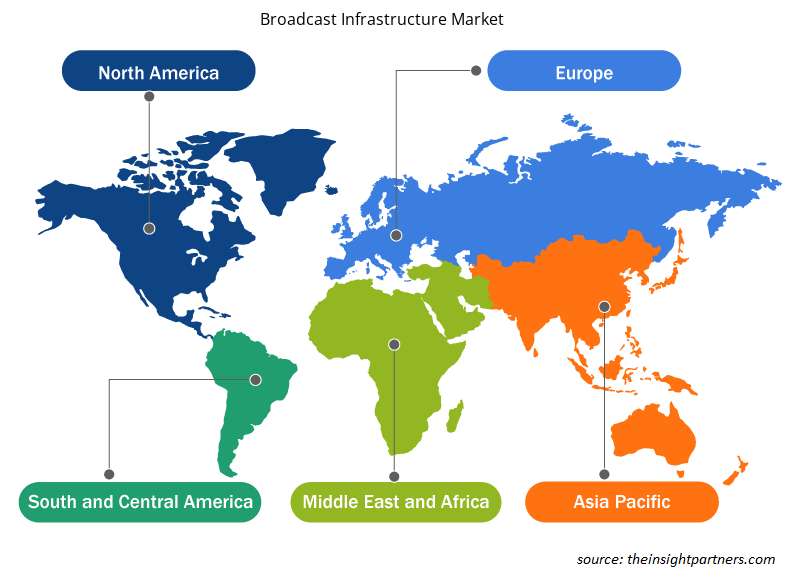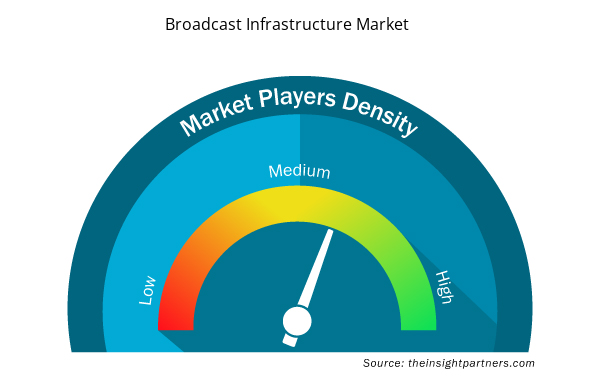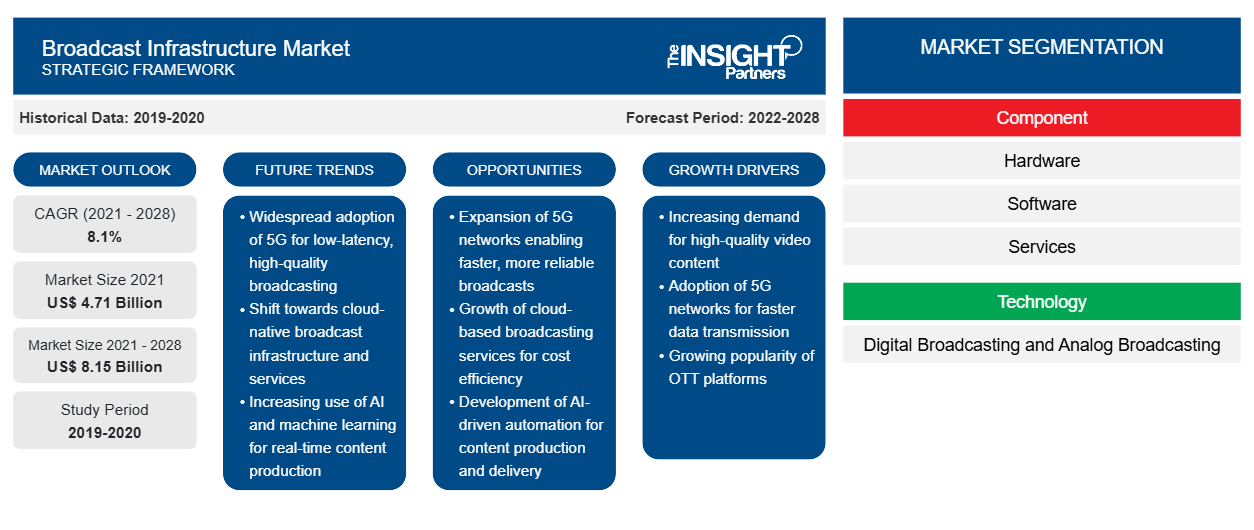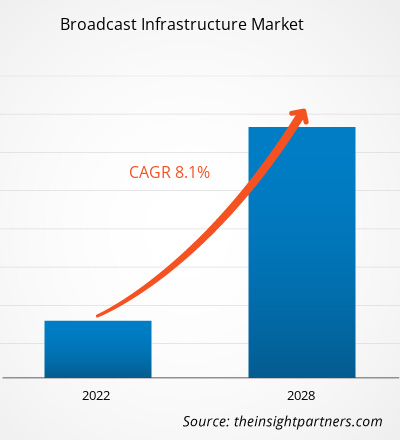[연구 보고서] 방송 인프라 시장은 2021년에 4,713.7백만 달러 규모로 평가되었으며, 2028년까지 8,145.7백만 달러에 도달할 것으로 예상됩니다. 2021년부터 2028년까지 연평균 성장률 8.1%로 성장할 것으로 예상됩니다.
방송 산업의 패러다임이 아날로그에서 디지털 기술로 전환되면서 비교적 복잡한 고급 방송 인프라가 도입되었습니다. 방송 산업은 인터넷 프로토콜 텔레비전(IPTV), 웹 TV, 고화질 텔레비전(HDTV), 페이퍼뷰와 같은 새로운 방송 기술에 대한 상당한 수요를 목격하고 있습니다. 풍부한 비디오 경험에 대한 수요는 전 세계, 특히 아시아 방송사에게 길을 열어줄 것으로 예상됩니다. 방송 인프라 시장을 주도하는 또 다른 핵심 요소 는 서버, 셋톱박스, 비디오 콘텐츠 보호 시스템으로 구성된 통합 플랫폼과 적절한 도구, 미들웨어, 청구로, 기본 IP 네트워크와 DSL 또는 광 액세스 시스템을 결합하여 비디오 온디맨드, 스트리밍, 타임시프트 TV와 같은 여러 형식으로 다양한 TV 서비스를 제공할 수 있습니다. 오늘날 공급업체는 방송 하드웨어 인프라의 높은 비용, 높은 유지 관리 비용, 빈번한 하드웨어 업그레이드로 인해 하드웨어 기반 인프라에서 소프트웨어 기반 인프라로 이동하고 있습니다. 방송 산업은 사용자에게 더 나은 경험을 제공하고 방송 인프라 공급업체에게 기회를 창출하기 위한 기술 개발로 획기적인 혁신을 겪고 있습니다.
귀하의 요구 사항에 맞게 이 보고서를 사용자 정의하세요
이 보고서의 일부 또는 국가 수준 분석, Excel 데이터 팩을 포함하여 모든 보고서에 대한 사용자 정의를 무료로 받을 수 있으며 신생 기업 및 대학을 위한 훌륭한 혜택과 할인 혜택을 이용할 수 있습니다.
- 이 보고서의 주요 시장 동향을 알아보세요.이 무료 샘플에는 시장 동향부터 추정 및 예측까지 다양한 데이터 분석이 포함됩니다.
COVID-19 팬데믹이 방송 인프라 시장에 미치는 영향
COVID-19 팬데믹으로 인해 많은 사람들이 재택근무를 하고 온라인에서 더 많은 시간을 보내며 디지털로의 전환을 자랑하고 있습니다. 이러한 디지털 리소스에 대한 수요는 여러 소프트웨어 및 플랫폼 조직의 시스템에 더욱 큰 스트레스를 주고 신뢰성과 품질로 서비스를 제공하는 역량을 방해하고 있습니다. 그러나 COVID-19 발발은 사업 중단과 노동력 부족으로 인해 최종 사용자에게 비디오 콘텐츠를 제공하는 플레이어에게 부정적인 영향을 미쳤습니다. COVID-19 위기는 또한 사업 봉쇄, 여행 금지 및 공급망 중단으로 인해 공급업체 네트워크에서 고객 배송 경험에 이르기까지 가치 사슬 전반에 걸쳐 운영을 크게 뒤집었습니다.
시장 통찰력 – 방송 인프라 시장
새로운 방송 기술 채택 증가
디지털화의 지속적인 개선과 가처분 소득의 증가로 시장은 IPTV와 HDTV의 높은 채택률을 목격하고 있습니다. 풍부한 비디오 경험에 대한 수요는 전 세계, 특히 아시아 지역의 방송사에게 길을 열 것으로 예상됩니다. 주문형 소비자 시청으로 인해 APAC 전역에서 광대역 확산이 증가하고 있습니다. 게다가 Netflix와 같은 구독 기반 OTT(Over-The-Top) 플랫폼이 아시아에서 인기를 얻고 있습니다. 클라우드 기반 인프라, 클라우드 기반 솔루션 및 관리 서비스, 하이브리드 네트워크에 대한 정부 지출 증가는 방송 인프라 시장 성장을 촉진할 것으로 예상됩니다. 보안 문제가 커지고 고객 신뢰를 유지하면 방송사가 새로운 제공 모델을 채택하게 될 것입니다. 모든 발전과 개발은 예측 기간 동안 시장 성장에 긍정적인 영향을 미칠 가능성이 높습니다.
구성 요소 기반 통찰력
구성 요소를 기준으로 방송 인프라 시장은 하드웨어, 소프트웨어, 서비스로 세분화됩니다. 소프트웨어 세그먼트는 2020년에 가장 큰 시장 점유율을 차지했습니다.
방송 인프라 시장 지역 통찰력
Insight Partners의 분석가들은 예측 기간 동안 방송 인프라 시장에 영향을 미치는 지역적 추세와 요인을 철저히 설명했습니다. 이 섹션에서는 북미, 유럽, 아시아 태평양, 중동 및 아프리카, 남미 및 중미의 방송 인프라 시장 세그먼트와 지리에 대해서도 설명합니다.

- 방송 인프라 시장을 위한 지역별 특정 데이터 얻기
방송 인프라 시장 보고서 범위
| 보고서 속성 | 세부 |
|---|---|
| 2021년 시장 규모 | 47억 1천만 달러 |
| 2028년까지 시장 규모 | 81억 5천만 달러 |
| 글로벌 CAGR (2021-2028) | 8.1% |
| 역사적 데이터 | 2019-2020 |
| 예측 기간 | 2022-2028 |
| 다루는 세그먼트 | 구성 요소별로
|
| 포함된 지역 및 국가 | 북아메리카
|
| 시장 선도 기업 및 주요 회사 프로필 |
|
시장 참여자 밀도: 비즈니스 역학에 미치는 영향 이해
방송 인프라 시장 시장은 소비자 선호도의 변화, 기술 발전, 제품의 이점에 대한 인식 증가와 같은 요인으로 인해 최종 사용자 수요가 증가함에 따라 빠르게 성장하고 있습니다. 수요가 증가함에 따라 기업은 제품을 확장하고, 소비자의 요구를 충족하기 위해 혁신하고, 새로운 트렌드를 활용하여 시장 성장을 더욱 촉진하고 있습니다.
시장 참여자 밀도는 특정 시장이나 산업 내에서 운영되는 회사나 기업의 분포를 말합니다. 주어진 시장 공간에 얼마나 많은 경쟁자(시장 참여자)가 존재하는지 그 규모나 전체 시장 가치에 비해 나타냅니다.
방송 인프라 시장에서 운영되는 주요 회사는 다음과 같습니다.
- 시스코 시스템즈 주식회사
- 클라이드 방송 기술
- CS컴퓨터시스템 주식회사
- 주식회사 다캐스트
- EVS 방송 장비 SA
면책 조항 : 위에 나열된 회사는 어떤 특별한 순서에 따라 순위가 매겨지지 않았습니다.

- 방송 인프라 시장 주요 주요 업체 개요 알아보기
방송 인프라 시장에서 활동하는 업체는 주로 고급적이고 효율적인 제품 개발에 집중하고 있습니다.
- 방송 및 뉴미디어 제작을 위한 라이브 비디오 기술 분야의 선도적 공급업체인 EVS는 2021년 6월, Gravity Media와 제휴하여 회사의 새로운 통합 비디오 심사 및 커뮤니케이션 솔루션을 위한 핵심 기술로 Xeebra 멀티 카메라 검토 시스템을 공급한다고 발표했습니다.
- 2021년 6월 Ross Video는 미디어 자산 워크플로 솔루션 회사인 Primestream을 인수했다고 발표했습니다. 이러한 솔루션은 기업, 디지털 미디어, 스포츠, 방송을 포함한 다양한 시장 수직 분야의 고객이 사용합니다. 해당 솔루션은 각 시장에서 고유하고 점점 더 복잡해지는 창의성, 비즈니스 및 기술 과제를 해결하도록 설계되었습니다. 이번 인수를 통해 Ross는 자연스럽게 Streamline 미디어 자산 관리 솔루션을 Primestream 제품과 결합하여 완전히 융합된 그래픽 및 프로덕션 자산 관리 플랫폼을 구축할 것입니다.
방송 인프라 시장은 다음과 같이 세분화됩니다.
방송 인프라 시장 – 구성 요소별
- 하드웨어
- 소프트웨어
- 서비스
방송 인프라 시장 – 기술별
- 디지털 방송
- 아날로그 방송
방송 인프라 시장 – 응용 프로그램별
- 오버더
- 지구의
- 위성
- IPTV
- 기타
방송 인프라 시장 – 지역별
- 북아메리카
- 우리를
- 캐나다
- 멕시코
- 유럽
- 독일
- 프랑스
- 이탈리아
- 영국
- 러시아 제국
- 유럽의 나머지 지역
- 아시아 태평양(APAC)
- 호주
- 중국
- 인도
- 일본
- 대한민국
- APAC의 나머지 지역
- 중동 및 아프리카(MEA)
- 사우디 아라비아
- 아랍에미리트
- 남아프리카 공화국
- MEA의 나머지
- 남미(SAM)
- 브라질
- 아르헨티나
- SAM의 나머지
방송 인프라 시장 – 회사 프로필
- 시스코 시스템즈 주식회사
- 클라이드 방송 기술
- CS컴퓨터시스템 주식회사
- 주식회사 다캐스트
- EVS 방송 장비 SA
- 그래스 밸리
- 칼투라
- 네비온
- 로스 비디오 유한회사
- 지시
- 역사적 분석(2년), 기준 연도, CAGR을 포함한 예측(7년)
- PEST 및 SWOT 분석
- 시장 규모 가치/양 - 글로벌, 지역, 국가
- 산업 및 경쟁 환경
- Excel 데이터 세트



Report Coverage
Revenue forecast, Company Analysis, Industry landscape, Growth factors, and Trends

Segment Covered
This text is related
to segments covered.

Regional Scope
North America, Europe, Asia Pacific, Middle East & Africa, South & Central America

Country Scope
This text is related
to country scope.
자주 묻는 질문
US led the broadcast infrastructure market globally with a market share of 68.7% in the year 2020. For instance, For instance in 2021, DigitalBridge Group, an American made an announcement to acquire a majority stake in Vertical Bridge, the largest operator of wireless communications infrastructure in the US with an aim to meet the rising demands for broadcast infrastructure solutions. Significant investments in the 5G infrastructure by the government of the US has created a tremendous long-term growth opportunities for telecommunications infrastructure in the region.
The major companies in broadcast infrastructure includes Computer System, Grass Valley, EVS Broadcast Equipment, Nevion, Kaltura, among others. The ranking has been derived analysing multiple parameters such as annual revenue earned from broadcast infrastructure portfolio, client base, geographic locations, R&D expenditure, brand image, and number of employees, among others. These companies are actively participating in developing broadcast infrastructure for various applications.
The broadcast infrastructures have been in use for several years worldwide, however, the technology has been experiencing immense demand in recent years. The noteworthy increasing adoption of new broadcast technologies and migration from hardware to software based infrastructure is supporting the growth of broadcast infrastructure market. Moreover, the demand for cloud-based solutions in the broadcast industry for low cost and high scalability increases, the opportunities for market players who provide cost-effective and efficient streaming will propel the growth of the market.
In 2020, North America led the market with a substantial revenue share, followed by Europe, and APAC. Asia Pacific is a prospective market for broadcast infrastructure market players.
Increasing demand of Digital Terrestrial TV (DTTV) is the key opportunity for the broadcast infrastructure market. Growing demand of smart TVs, and advancements in telecom and broadcast industry is anticipated to drive the growth of Digital Terrestrial Television (DTT). With increasing consumption of TV sets and expenditure on terrestrial networks for quality, entertainment, and family friendly purpose, the demand for DTT has boosted.
The global broadcast infrastructure market was dominated by terrestrial segment with market share of 44% in 2020. Terrestrial television refers to methods of television broadcasting which do not include satellite transmission or through underground cables. The transition to digital terrestrial TV from analog terrestrial TV can be considered a significant development for the broadcasting industry. While the implementation of digital broadcasting has been led by satellite, cable, and to some extent IPTV, it is the evolution of the terrestrial broadcast platform that perhaps brings most benefits to the society.
Trends and growth analysis reports related to Electronics and Semiconductor : READ MORE..
The List of Companies - Broadcast Infrastructure Market
- Cisco Systems, Inc.
- Clyde Broadcast Technology
- CS Computer Systems Ltd.
- Dacast Inc.
- EVS Broadcast Equipment SA
- Grass Valley
- Kaltura
- Nevion
- Ross Video Ltd
- Zixi
The Insight Partners performs research in 4 major stages: Data Collection & Secondary Research, Primary Research, Data Analysis and Data Triangulation & Final Review.
- Data Collection and Secondary Research:
As a market research and consulting firm operating from a decade, we have published and advised several client across the globe. First step for any study will start with an assessment of currently available data and insights from existing reports. Further, historical and current market information is collected from Investor Presentations, Annual Reports, SEC Filings, etc., and other information related to company’s performance and market positioning are gathered from Paid Databases (Factiva, Hoovers, and Reuters) and various other publications available in public domain.
Several associations trade associates, technical forums, institutes, societies and organization are accessed to gain technical as well as market related insights through their publications such as research papers, blogs and press releases related to the studies are referred to get cues about the market. Further, white papers, journals, magazines, and other news articles published in last 3 years are scrutinized and analyzed to understand the current market trends.
- Primary Research:
The primarily interview analysis comprise of data obtained from industry participants interview and answers to survey questions gathered by in-house primary team.
For primary research, interviews are conducted with industry experts/CEOs/Marketing Managers/VPs/Subject Matter Experts from both demand and supply side to get a 360-degree view of the market. The primary team conducts several interviews based on the complexity of the markets to understand the various market trends and dynamics which makes research more credible and precise.
A typical research interview fulfils the following functions:
- Provides first-hand information on the market size, market trends, growth trends, competitive landscape, and outlook
- Validates and strengthens in-house secondary research findings
- Develops the analysis team’s expertise and market understanding
Primary research involves email interactions and telephone interviews for each market, category, segment, and sub-segment across geographies. The participants who typically take part in such a process include, but are not limited to:
- Industry participants: VPs, business development managers, market intelligence managers and national sales managers
- Outside experts: Valuation experts, research analysts and key opinion leaders specializing in the electronics and semiconductor industry.
Below is the breakup of our primary respondents by company, designation, and region:

Once we receive the confirmation from primary research sources or primary respondents, we finalize the base year market estimation and forecast the data as per the macroeconomic and microeconomic factors assessed during data collection.
- Data Analysis:
Once data is validated through both secondary as well as primary respondents, we finalize the market estimations by hypothesis formulation and factor analysis at regional and country level.
- Macro-Economic Factor Analysis:
We analyse macroeconomic indicators such the gross domestic product (GDP), increase in the demand for goods and services across industries, technological advancement, regional economic growth, governmental policies, the influence of COVID-19, PEST analysis, and other aspects. This analysis aids in setting benchmarks for various nations/regions and approximating market splits. Additionally, the general trend of the aforementioned components aid in determining the market's development possibilities.
- Country Level Data:
Various factors that are especially aligned to the country are taken into account to determine the market size for a certain area and country, including the presence of vendors, such as headquarters and offices, the country's GDP, demand patterns, and industry growth. To comprehend the market dynamics for the nation, a number of growth variables, inhibitors, application areas, and current market trends are researched. The aforementioned elements aid in determining the country's overall market's growth potential.
- Company Profile:
The “Table of Contents” is formulated by listing and analyzing more than 25 - 30 companies operating in the market ecosystem across geographies. However, we profile only 10 companies as a standard practice in our syndicate reports. These 10 companies comprise leading, emerging, and regional players. Nonetheless, our analysis is not restricted to the 10 listed companies, we also analyze other companies present in the market to develop a holistic view and understand the prevailing trends. The “Company Profiles” section in the report covers key facts, business description, products & services, financial information, SWOT analysis, and key developments. The financial information presented is extracted from the annual reports and official documents of the publicly listed companies. Upon collecting the information for the sections of respective companies, we verify them via various primary sources and then compile the data in respective company profiles. The company level information helps us in deriving the base number as well as in forecasting the market size.
- Developing Base Number:
Aggregation of sales statistics (2020-2022) and macro-economic factor, and other secondary and primary research insights are utilized to arrive at base number and related market shares for 2022. The data gaps are identified in this step and relevant market data is analyzed, collected from paid primary interviews or databases. On finalizing the base year market size, forecasts are developed on the basis of macro-economic, industry and market growth factors and company level analysis.
- Data Triangulation and Final Review:
The market findings and base year market size calculations are validated from supply as well as demand side. Demand side validations are based on macro-economic factor analysis and benchmarks for respective regions and countries. In case of supply side validations, revenues of major companies are estimated (in case not available) based on industry benchmark, approximate number of employees, product portfolio, and primary interviews revenues are gathered. Further revenue from target product/service segment is assessed to avoid overshooting of market statistics. In case of heavy deviations between supply and demand side values, all thes steps are repeated to achieve synchronization.
We follow an iterative model, wherein we share our research findings with Subject Matter Experts (SME’s) and Key Opinion Leaders (KOLs) until consensus view of the market is not formulated – this model negates any drastic deviation in the opinions of experts. Only validated and universally acceptable research findings are quoted in our reports.
We have important check points that we use to validate our research findings – which we call – data triangulation, where we validate the information, we generate from secondary sources with primary interviews and then we re-validate with our internal data bases and Subject matter experts. This comprehensive model enables us to deliver high quality, reliable data in shortest possible time.


 이 보고서에 대한 무료 샘플을 받으세요
이 보고서에 대한 무료 샘플을 받으세요